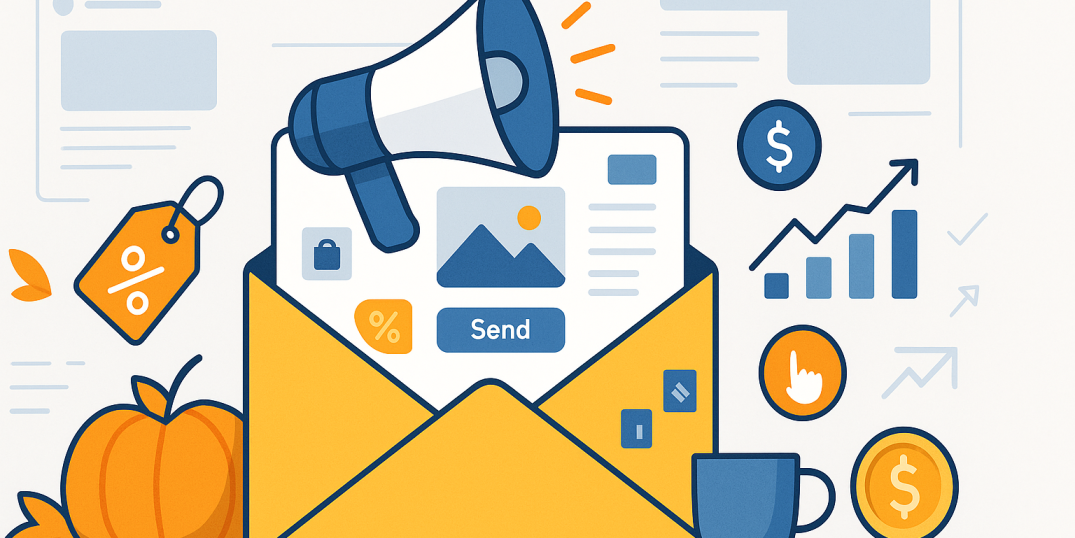- Home
- Fundamentals of Email Marketing
- Advertising by Email vs. Email ...

Marketing, email marketing, advertising emails. If you think all those terms are the same, you are not alone: many people share this sentiment. However, not all communication is the same, and email marketing is quite different from advertising by email. And as such, advertising should only be a part of your overall marketing strategy—an important one, however.
Using the right ads in emails is crucial, as emails are a very intimate and strong contact point to foster and establish a relationship with your clients. In simple terms, advertising by email means sending direct promotional messages to your subscribers to grab their attention quickly and trigger action.
Why is advertising by email often confused with email marketing? Both use the same channel, both land in the same inbox, and both can even use similar design elements. But there is a difference in intent. Email marketing covers the broader ecosystem of communication, while advertising emails, on the other hand, are narrower in scope and sharper in purpose: they are built to sell, persuade, or announce.
How to send a good advertising email is not a question we will leave unanswered. Quite the opposite—we will show you what it takes to really engage with your community and use email advertising as an effective tool without confusing it for the broader discipline of email marketing.
What Is Advertising by Email?
Email marketing is a broad ecosystem that includes newsletters, educational content, promotions, nurturing flows, and more. It is also primarily meant for relationship building. Advertising by email, on the other hand, is sharper and more straightforward. It’s about using the inbox for direct promotional messages that are meant to sell, persuade, or announce. It is transactional in nature, so it is focusing less on dialogue building and more on immediate impact.
Let’s look at the difference. When a company sends a newsletter, it may share industry insights or offer useful tips. But when it sends an advertising email, the aim is very specific: “50% off today only,” “Our new collection just dropped,” “Book your seat now.” These messages are not meant to be conversational—they are supposed to drive immediate action.
👉 Core definition: Advertising by email means using email as a direct channel for promotional messages. Each email advertisement is designed to stand out and demand attention quickly.
👉 Difference from general email marketing: Email marketing campaigns often nurture trust and deliver value over time, while advertising emails are immediate, transactional, and focused on one clear call to action.
👉 Typical goals: Short-term and concrete—sell a product, push seasonal promotions, announce a launch, or remind customers of an offer before it expires. Ads in emails resemble banners or concise showcases rather than long editorial content.
Advertising by Email vs. Email Marketing
Since both types of emails arrive in the same inbox and often use similar tools, it is easy to confuse the two. But, as we previously figured out, advertising by email and email marketing are not the same. One is a tactic, while the other one is a strategy. For better understanding, let’s look at a quick side-by-side comparison of advertising by email vs. email marketing:
| Aspect | Advertising by email | Email marketing |
| Purpose | Immediate sales, product launches, seasonal promotions | Relationship building, nurturing leads, delivering value |
| Tone | Direct, transactional, attention-grabbing | Informative, conversational, trust-driven |
| Format | Email advertisements, banners, product showcases | Newsletters, nurture flows, educational content |
| Timeframe | Short-term results (clicks, purchases) | Long-term growth (loyalty, retention, engagement) |
📌 Advertising by email as a subset: Advertising emails fit inside the larger umbrella of email marketing. They are one of the many tools marketers can use, but they are not the whole strategy. While newsletters, onboarding flows, and educational content work to build trust and maintain long-term engagement, advertising emails are reserved for short-term goals like sales or launches. An email advertisement makes sense only when it supports the overall strategy, not when it stands alone.
📌 Why integration matters: Relying only on ads in emails can feel pushy and unsustainable. Subscribers quickly stop engaging if every message is a promotion. But when advertising by email is integrated into a broader plan, it adds balance. A newsletter can inform and create trust, while an advertising email can step in at the right moment to drive action. Together, they form a complete approach that keeps them engaged and converts them when it matters most.
Email marketing example (newsletter)

Best Practices for Successful Email Advertising
✨ Keep it single-minded. A newsletter can cover a wide range of topics—from cooking tips to ideas for presents for Mother’s Day. An advertising email cannot do that. It should revolve around one central message, usually a discount, a launch, or a reminder, and guide the reader directly to a single call to action.
✨ Make subject lines with urgency and clarity. While a newsletter subject line might be creative, have an open question mark, or be curiosity-driven, a subject line for an email advertisement needs to be one thing only: clear. It is important to tell the reader upfront what they gain (“Extra 20% Off Ends Tonight”).
✨ Use strong visuals sparingly. Visuals play a supporting role in both types of emails, but the balance is different. In a newsletter, images might enhance the story or illustrate the content. In ads, visuals are often the message itself, so they should highlight the offer but not distract from it.
✨ Design for quick scanning. With newsletters, some readers may spend a few minutes skimming through content because they are meant to be readable. Advertising emails should be scannable in seconds, so aim for short headlines and clear buttons that will help you achieve your goal.
✨ Segmentation matters. Segmentation is always crucial for email marketing, but even more so for advertising by email. Nobody wants to get generic ads, especially for products they don’t need. Send offers for particular products or services only to people who have shown interest in them or in similar products.
✨ Respect frequency. Regular newsletters can go out weekly or even more often without irritating subscribers if they provide real value. Advertising emails are less forgiving in this regard. Too many promotions in a short time frame can really cause customer fatigue, so being strategic and relevant here is important.
✨ Test timing and offers. In general email marketing, you may test different subject lines or formats. With email advertising, testing timing and offer framing is especially important. “20% Off Now” versus “Buy One, Get One Free” can create different responses depending on your audience.
Email advertisement example

To Sum Up
In this article, we showed that advertising by mail is not about fostering ongoing loyalty (though that can happen as a side effect), but rather it’s about treating the inbox as an advertising space in itself. And like any ad channel, success depends on knowing how to send advertising email effectively.
As with most things relating to advertising (and email marketing in general), always keep your clients’ perspective in mind. Because the truth is: even the best copy can’t sell a product that’s marketed to the wrong customer or at the wrong moment. And with the ongoing onslaught of spam emails, newsletters, and business emails, it becomes imperative to stand out with your advertising emails. Follow our guidelines to make sure you stand out in a positive and memorable way.



